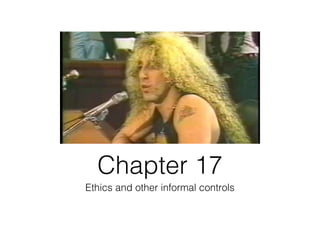
Ch17: Ethics
- 1. Chapter 17 Ethics and other informal controls
- 2. Personal ethics • Ethics: rules of conduct or principles of morality that guide us toward the right or best way to act in a situation • At some point, those working in the media may have to make an ethical decision about content • A model for ethical decisions:
- 3. A model for ethical decisions • First, define the situation. Establish the facts. • Determine what values are involved. Clarify values. • What ethical principles apply? State principles. • To whom do we owe a moral duty? Deter mine loyalties.
- 4. Performance codes • There is no professional review board for those in the media, instead many industries are self-regulated • Print media: American Society of Newspaper Editors (ASNE est. 1923), • Adopted the Canons of Journalism: responsibility, freedom of the press, independence, accuracy, impartiality, fair play and decency
- 5. Print media Society of Professional Journalists (SPI) have four main principles: 1.Seek the truth and repor t it. Journalists should be honest, fair and courageous in reporting the news 2.Minimize har m. Journalists should treat sources, subjects, and colleagues as human beings deserving of respect 3.Act independently. Journalists should be free of obligation to any interest other than the public's right to know 4.Be accountable. Journalists should be accountable to their audience and to each other • Gannett Company has their own principles that forbid lying to get a story, fabricating news, publishing misleading photographs Video
- 6. Broadcasting • National Association of Broadcaster NAB code est. 1929, abandoned in 1983 but its impact lingers • 1990 NAB issued voluntary guidelines for four areas: children's TV, indecency, violence and drug use/substance abuse • Radio and Television News Directors Association have an 11- part code for broadcast journalists • V-chip ratings system
- 7. Motion pictures • Production Code 1930 • MPAA Rating System 1968
- 8. Advertising industry The American Association of Advertising Agencies Standards of Practice (1924) •Covers contracts, credit extension, unfair tactics and the creative side of advertising - which contains provisions prohibiting misleading price claims, offensive statements, and the circulation of harmful rumors about a competitor Advertising Code of American Business Public Relations Society of America
- 9. Organizational policies TV Networks • Standards and Practices departments • Producers • Policy book: spells out a station's philosophy and standards of operation
- 10. Organizational policies Newspapers and Magazines • Operating policies: cover everyday problems and situations. Vary from one paper to another, may cover matters such as paying sources, conducting electronic surveillance, conflicts of interest • Editorial policies: guidelines that the newspaper or magazine follows to achieve specific goals, such as a political view. • Boosterism: favoring "good news" over negative news stories
- 11. Organizational policies Advertising • National Advertising Review Council: objective to sustain high standards of truth and accuracy in advertising • National Advertising Division: evaluates complaints • National Advertising Review Board: reviews contested complaints, may call on the FTC
- 12. Outside influences Economic pressure • Pressure from advertisers • Product placement in films/TV • Stories critical of commercial sponsors/ favorable news/placement for sponsors
- 13. Outside influences Pressure groups • Citizen groups can put pressure on broadcasters and content producers through boycotts, lobbying and presence in the press • ACT (Action for Children'sTelevision): achieved the passing of the Children's Television Act 1990 • Parents Television Council urges members to file complaints with the FCC • Parents Music Resource Center: creation of age restricted music sales
